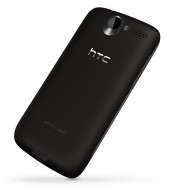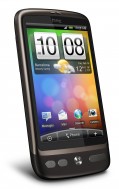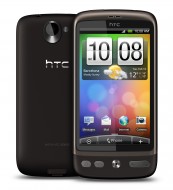If you’re looking for new Android phones in the US, you’re probably looking at the Nexus One or the HTC Incredible, but if you’re an overseas reader, you’re probably staying away from those. You could get a Nexus One across the pond, but if you’re taking a look around, you should check out HTC’s other flagship on Android, the Desire. Featuring the same blazing Snapdragon processor and 480×800 AMOLED screen, in addition to more RAM, this beast was meant to fly.
If you’ve read Nexus One reviews, you basically know about the Desire’s hardware, save a couple key differences: the Nexus One has a physical trackball and a secondary microphone for noise cancellation, while the Desire has more RAM, physical buttons instead of touch-sensitive ones and an optical trackpad instead of the trackball. They also differ in availability, as the Desire is strictly a European model, while the Nexus One is beginning to have a global presence.
The Droid Incredible, on the other hand, is a CDMA device, which makes it incompatible with most of Europe. It offers improved hardware in the form of a better camera (8MP vs 5) and 802.11n WiFi–a new trick for a phone.
Otherwise, the Desire and the Nexus One have the same camera, processor, form factor, screen resolution, screen size and more. In other words, software and carrier are the major differences between the other high-end Android phones right now. And since Sense is the primary difference here, let’s give the software side of the Desire a closer look.
Software
Sense is the name of the overarching UI changes HTC has applied to Android. It’s a complete replacement for the user interface, which provides a new launcher that includes options to jump straight to the phone and add things to the home screen, Sense-specific widgets with their own interactivity and other tweaks.
The lock screen is also HTC-specific, and it allows you to snooze the alarm when it goes off, slide down to answer a call and slide up to dismiss a call. The screen also shows information such as missed calls, time and date and so on.
When unlocked, if the time and weather widget is on screen (shown right), an animation corresponding to the current weather plays–clouds drift across the screen, rain pounds, or the sun shines brightly. It’s a nice touch, and uniquely Sense.
The upgraded Sense shipping with the Desire also includes a pinch-to-workspace feature. Pinching together on a Desire’s home screen will zoom out, showing all available workspaces and what’s on their screens, allowing you to jump directly to them. It’s a nice touch you can miss when going to other home replacements.
As mentioned, there are several widgets that are Sense-specific: the weather and clock widget at right, a FriendStream widget that shows contacts’ Facebook updates, an Exchange mailbox widget that shows your messages and lets you jump right in, as well as bookmark, news, RSS widgets and a lot more. There are also HTC-specific implementations of contacts (People), the phone dialer, the text messaging app and more.
The Desire also runs Flash Lite out of the box. Flash ads in websites play correctly in the included browser. Videos run in an app that gets launched when clicked, then return you to the site with no interruption. It won’t play Flash games or run Hulu, but it’s a start before Adobe releases Flash 10.1 this summer.
The browser also includes text reflow, which is handy. The browser itself displays the entire screen when surfing on the Desire, so you occasionally have to zoom in to read text. When you zoom, the text will reflow, adjusting its width to the width of the screen, in whichever orientation you are holding it and at whatever magnification you’re using. Pinch-to-zoom also works here, so you zoom in by spreading your fingers apart, and the text magically rearranges itself for you.
HTC’s also included an FM radio application that takes advantage of the Desire’s hardware, allowing you to listen to regular old radio when you have your headphones plugged in–they act as the antenna.
Connectivity and connectedness is the overarching theme behind Sense. When you set up the Desire (or any Sense phone) for the first time, it’ll ask you if you’d like to connect your Facebook account, Twitter account and Flickr account. Connecting Facebook is very useful–Sense will check your friends, compare them against your contacts and suggest matches. If it finds them (and it’s found all of mine), it will suggest using their profile picture as their contact image, and will set their birthday as well. If you connect it to Flickr, when you take or view an image, you can share it out to Flickr, which will upload it to your account for you. That level of integration is what makes Sense work for you instead of against you.
I’ll go ahead and suggest that you do not link your Twitter account here. Peep, HTC’s Twitter client, isn’t the best one out there, and other apps also offer the same level of integration. I, as an example, use Twidroid Pro, and it also digs itself in, allowing you to choose it when sharing images, web pages, text and more. Peep will likely work for many, but you can always set it up later, as well.
Usage and activity
 As a phone, the Desire is perfectly fine. It has better reception and call quality than many of my recent phones and many of its competitors, but it’s nothing to write home about. It’s a phone. You can hear people, and they can hear you. It’s great.
As a phone, the Desire is perfectly fine. It has better reception and call quality than many of my recent phones and many of its competitors, but it’s nothing to write home about. It’s a phone. You can hear people, and they can hear you. It’s great.
As a smartphone, the Desire is fantastic. The Snapdragon processor really shines, putting older ~600MHz phones to shame. It was a real, noticeable step up from my first-gen European HTC Hero: apps open faster, scrolling is smoother and the phone is generally more responsive. This is the way smartphone computing was meant to be.
I have never noticed stutters in the interface, drags while something’s running, or chokes during network activity–all minor problems on the Hero. Android’s app management–closing apps in the background when they’re not needed, freeing up RAM for active tasks, saving task states for quick resumes–works very well on the Desire.
Camera
The camera is solid, too. The Desire features a sharp 5MP lens, and the preview fills the screen during shooting. You can tap to focus on a specific area, then either tap and hold the screen or click the trackpad to take the picture. It probably won’t attract awards for everyday shots, but with a little work, you can get very nice pictures out of it. The low-light response is better than the Hero, and the LED flash is actually ridiculously bright at middling ranges.
Battery life
Battery life is is dependent on usage, of course, but during a normal day’s use (after you get over playing with it all the time), I can get through a 7 AM-to-11 PM day with around 30-40% battery remaining. There are many ways to kill the battery, though. Leave WiFi on but unconnected, and you’ll drain it. Leave the screen on the highest brightness all the time, and you’ll drain it. Leave the data connection on all the time, and you’ll drain it. Leave the GPS on all the time, and you’ll drain it.
There are some quality apps to combat the drain (Juice Defender), but logical usage will keep you safe more often. Turn off the WiFi radio when you’re outside of wireless. Disable APN when WiFi is available. Only use GPS when tower triangulation just won’t do. In other words, this is still a smartphone that’s subject to the limitations of batteries. Extended batteries haven’t yet come out, but they’re not strictly necessary just yet.
Daily usage
With all current smartphones, the device is important, but the real value comes from what you can run on it. The Desire has, of course, the Android market from which to choose applications, and it benefits from the higher-resolution screen–those apps that are coded for higher definition will be able to take advantage of the Desire’s extra pixels.
The amount of storage offered by the Desire is also sufficient for most app usage, but if you’re going wild and installing Google Earth and nav programs and high-resolution games, you’ll run out. That’s an edge case, however, and for those folks, there’s a special section at the bottom of this review.
Quirks
I’ve encountered two quirks while using the phone, both of which could be specific to me. The first is the sensitivity of the screen. It’s capacitive, which means it uses the electrical properties of human skin to gauge the location of the “cursor.” In several situations, I have moved items on the screen without actually touching the screen, and I routinely throw the device into confusion if I try to hold it with one hand and navigate with my thumb; the heel of my thumb gets close enough to the bottom edge of the screen that, when I touch something with my thumbtip, it registers as two contacts, which can have unexpected results. I am evidently more capacitive than others.
The screen is, however, still very sensitive. Many users have reported having to take care when removing a phone from a pocket or phone pouch, as the upward or downward-sliding action on the Sense lockscreen can be triggered to accidentally ignore or answer calls.
The other quirk is with the headphones and music playback. The buttons on my Desire’s included earbuds have inline controls for track forward, back and pause, but they’re not always consistent, and I haven’t ascertained if it’s the fault of the buttons, the connection in the jack, or a software issue. As I’ve not found other users with the same issues, I will consider it a fluke.
Extracurriculars
The Desire community has been vitalized over the recent rooting accomplishment by Paul O’Brien over at MoDaCo. Custom ROMs have begun to spring up that remove Sense, update different software packages, tweak install locations, and more. There’s even a preliminary CyanogenMod ROM available for weekend experimentation.
The root isn’t a full, pure root yet, though. HTC installed some additional security measures that prevents writing to the system directory while the phone is out of recovery mode. That’s still being worked on. The majority of root-requesting apps, however, appear to function for the moment. ROM flashing is already in full swing, with chefs pushing out at least three different variants (Cyanogen, eViL, and amhgsk) of ROMs so far, and root was only achieved last week
 For those who’d like to give it a go, Apps2SD is functioning with root on the Desire, and my testing confirms it. Apps2SD is a way to redirect app installation paths to a special partition on the SD card, allowing you to have more space to install apps and leave your phone’s internal memory for contacts, messages, etcetera. Some users have had serious trouble–loss of the use of USB communication with their phones–but this appears to be isolated, and my installation has had no such troubles. If you’re concerned, it might be prudent to wait until it’s been sorted out; the fine developers at both MoDaCo and XDA-Devs have been checking it out.
For those who’d like to give it a go, Apps2SD is functioning with root on the Desire, and my testing confirms it. Apps2SD is a way to redirect app installation paths to a special partition on the SD card, allowing you to have more space to install apps and leave your phone’s internal memory for contacts, messages, etcetera. Some users have had serious trouble–loss of the use of USB communication with their phones–but this appears to be isolated, and my installation has had no such troubles. If you’re concerned, it might be prudent to wait until it’s been sorted out; the fine developers at both MoDaCo and XDA-Devs have been checking it out.
Final thoughts
So, is the Desire the right phone for you? If you’re looking for a GSM phone with very nearly the best hardware on the market in Europe, it probably is. As for us, we at Icrontic give it a sincere outstanding product badge. Congratulations, HTC, on yet another fantastic handset.










 Articles RSS
Articles RSS